It’s no wonder spearfishing has seen a rapid growth in the last few years; it’s exciting, fun, keeps you fit and provides fantastic fish for the table.
I’ve been spearfishing for over 35 years, and I’ve even won a few championships (seven time Australian Open Spearfishing Champion), and I love introducing this incredible sport to a wider audience. In the following I will be outlining the basics of spearfishing and how you can get involved in this great sport.
Indigenous Australians have been practicing spearfishing for thousands of years as a means to feed the family, and in more recent years it has developed as a serious sport. It is now recognised as a challenging and very selective sustainable fishing method. One can choose the species and size of fish that is targeted and only take what is needed.
The majority of spearfishing in Australia is done while freediving. Also known as skindiving and snorkelling, freediving is a technique that involves holding your breath and submerging underwater without the use of SCUBA equipment.
It is important to be a competent freediver if you want to get into spearfishing as it is illegal to spearfish on compressed air in New South Wales, Queensland and Northern Territory.
Spearfishing while freediving is a relatively safe and an effective means of catching a feed of fresh fish, lobster, abalone and scallops.
One of the best ways of getting involved with spearfishing is by joining a club. The club will provide practical and regular helpful information on how, where and when to go spearfishing. They have regular club meetings, competitions, guest speakers, information nights and, most importantly, dives. A club is a very effective means of learning the basics on spearfishing and fast tracking your learning curve.
If you are unable to join a club, then other options to consider are: spearfishing courses, charters, watching instructional DVDs and reading media. A good book available in Australia is Underwater Fishing in Australia and New Zealand by Dr. Adam Smith, Mountain, Ocean and Travel Publications.
The peak governing body on spearfishing in Australia is the Australian Underwater Federation, (www.auf.com.au ). I have been a financial member of this organisation for over 30 years and I am constantly learning from this association. They have regular newsletters and are active in ensuring the best for spearfisher interests.
In the past ten years or so there has been a number of dedicated spearfishing shops open in Australia. These retailers are a good source of information and are generally happy to share tips and knowledge with the up and coming learner.
A great place to start spearfishing is in the protection of calm bays, as opposed to the open ocean. In Victoria, locations around Port Philip Bay such as Mornington, Black Rock, Indented Head, offer safe entry level locations. Once you become comfortable in the bay try areas such as Phillip Island, the Mornington Peninsular back beaches and areas along the West Coast such as Apollo Bay and Port Fairy.
In New South Wales good spearfishing can be found around Sydney and as far south as Eden. The south coast hot spots include areas such as Green Cape, Merimbula, Narooma, Batemans Bay and Wollongong. Further north, good locations include Port Stephens and Coffs Harbour.
Queensland has a diverse range of spearfishing locations such as the Great Barrier Reef, Moreton Island, North Stradbroke Island and the Tweed Heads region.
The basic minimum gear requirements include a mask, snorkel, fins, dive knife, gloves, Hawaiian sling or spear gun and divers float (complete with alpha flag and tow rope).
Wet suits are optional depending on water temperatures and the duration you plan to spend in the water. Wetsuits used for spearfishing in Australia are generally between 3-5mm thick and you will need weight belts to compensate for the buoyancy of the neoprene. Be very careful not to use too many weights as this can prove to be very dangerous.
More advanced gear can be added depending on the exact type of spearfishing being done.
Reef spearfishing is a great way to start. Typical species for newcomers along the south and east coasts include bream, sweep, salmon, morwong, leatherjackets, snapper, whiting, trevally and rock blackfish. In Queensland, reef species include the very tasty coral trout, various emperor species, parrotfish, mangrove jacks, and many more.
With a bit of practise you can also target blue water species, such as yellowtail kingfish, Spanish mackerel, wahoo and even billfish. This type of spearfishing is known as blue water hunting.
Blue water hunters target areas around offshore fish attracting devices, the Continental Shelf, offshore sea mounts and offshore islands. Prized fish once thought to be the sole realm of traditional game fishers are now being landed by serious blue water hunters.
Diving from boats is the safest way of spearfishing, however, most states also offer great land-based diving. The first ten years I spearfished was land-based and it is great fun. Just remember to always tow a float and have a safe exit location in mind prior to starting the dive as weather conditions can change.
The rules and regulations relating to spearfishing vary slightly between the states. It can be quite confusing trying to navigate marine protected areas, and also some areas allow line fishing but not spearfishing, and some species are allowed to be caught line fishing but not spearfishing…and so on.
Nevertheless, it is a spearfisher’s obligation to know the local regulations. Each State Fisheries department produce a very helpful free handbook that covers the relevant rules and regulations and this is a great starting point. These are available at most fishing retail outlets.
Spearfishing like all sports must adhere to safety procedure. If you follow some basic principles then spearfishing is relatively safe:
• Always dive with a buddy and keep eye contact on each other at all times;
• Never attempt to dive in deeper water than you are comfortable with;
• Do not tether speared fish to your body, tow them on a trailing float or remove them from the water;
• Gain local knowledge about your dive sites and be aware of currents, ocean swells and dirty water. Always tell someone where you plan to dive.
• Never load your spear gun out of water and cover the spearhead at all times while not in use.
Recently, Australia’s leading spear fishing governing body, The Australian Underwater Federation received a government grant to develop a Safe Spear fishing Iniative Program and this has resulted in the production of a DVD, a brochure and stickers. These will be available free from spearfishing shops, clubs and organisations in the coming weeks.
Reads: 35502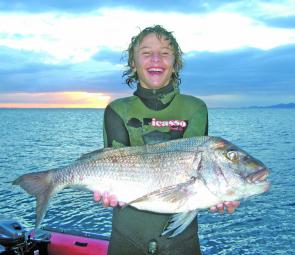
Jake Morris Torelli, 13 year old, and a fine 5.5kg snapper. Spearfishing is a safe sport for the whole family as long as you follow safety procedures.
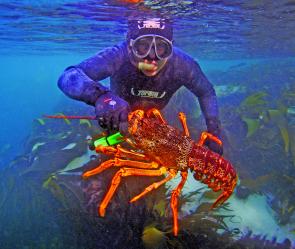
A tasty crayfish hand caught from the Victorian south coast.
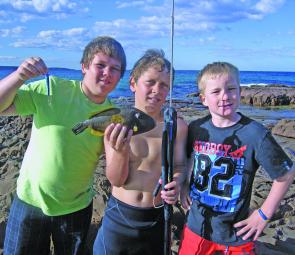
Proud up and coming spearos on NSW South coast.
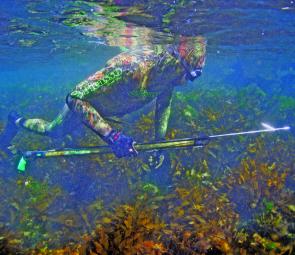
Spearfishing gear has gone hi-tech with camouflage wetsuits and spearguns.
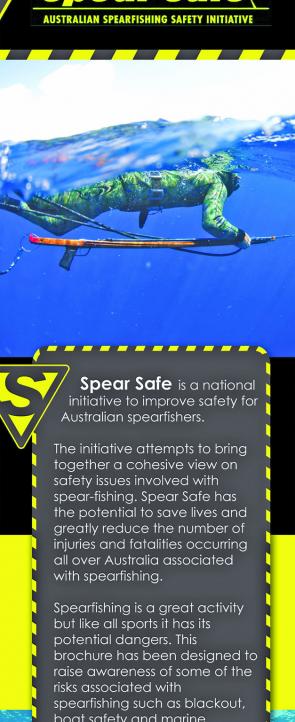
Spearsafe Brochure Cover
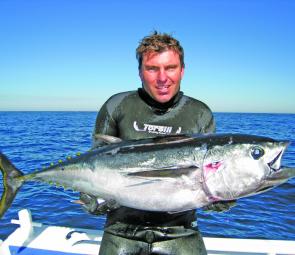
The author and his first ever southern blue fin tuna taken off the Continental Shelf off Portland, Victoria.

The tasty coral trout, a popular fish from Queensland’s Great Barrier Reef.

Victorian spearfishing Champion Drew Fenney and a snook.




